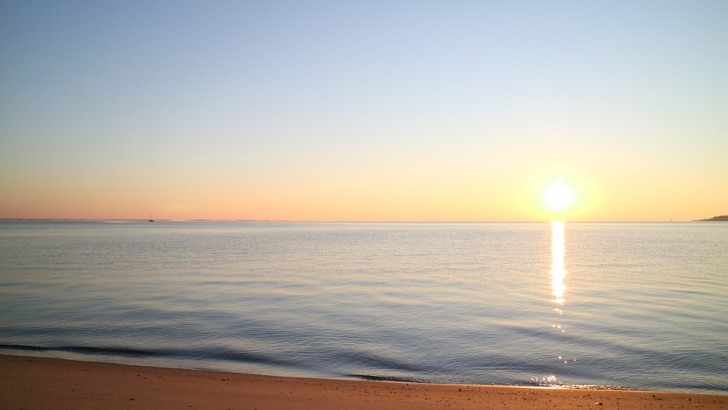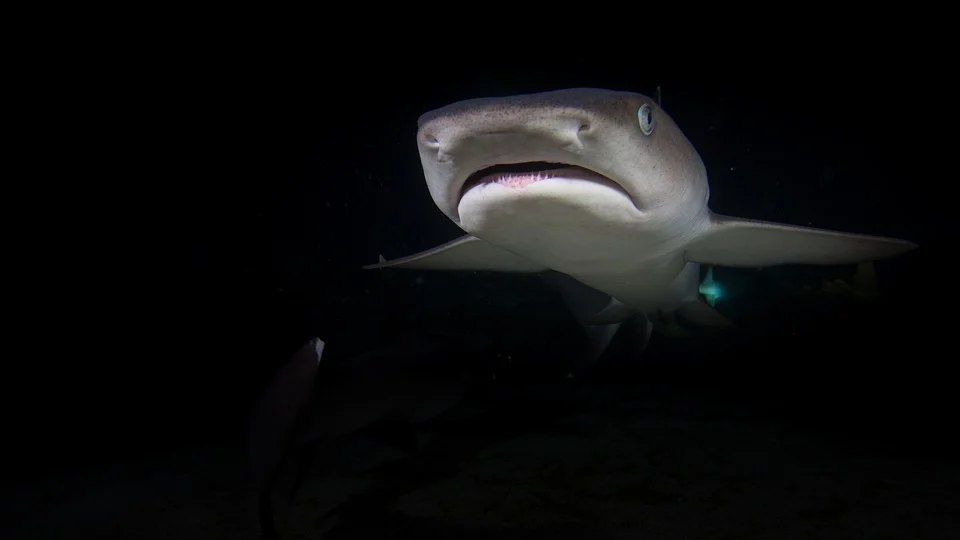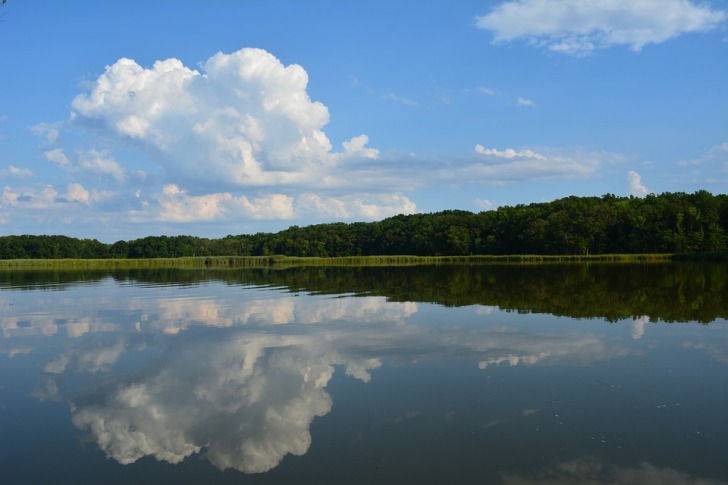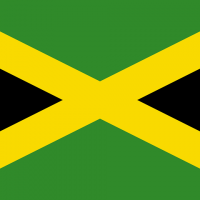The 200-mile stretch of waters known as the Chesapeake Bay extends from Washington, Delaware, and Virginia.
Midsummer temperature averages compare to Caribbean beaches, and the warm, sunny days here attract just as many visitors as would the Pacific Coast on the opposite side of the United States.
Contents
- So… Are There Sharks in the Chesapeake Bay?
- Shark Species in the Chesapeake Bay
- Other Chesapeake Bay Sharks
- Is it Safe to Swim in the Chesapeake Bay?
- Interesting Shark Facts in the Chesapeake Bay
- Other Interesting Shark News
- Sharks in Freshwater Vs. Saltwater
- 3 Safety Tips for Swimming in Shark-infested Waters
- Summary
- Chesapeake Safety Overview
- Frequently Asked Questions
So… Are There Sharks in the Chesapeake Bay?
An estimated dozen species of sharks (11-13 species) frequent this area as reported in 2021 by the Chesapeake Bay Program, with five being present more often than the rest.
The Sandbar Shark, which you can find from here down to Brazil in South America, seems to stick around more than the other species.
It migrates to the East Coast from the south in the summer and returns to southern locations before winter.

You will see that the first five shark species listed below are the most often.
First, you will learn more about the Sandbar Shark.
Then, you will become acquainted with six other variants of this sea creature that at least on rare occasions do make an appearance.
1. Sandbar
This one usually stays near the bottom of the ocean, and the ones present during the warmer months in the Chesapeake Bay are often the young ones.
When it wants to eat, it usually looks for rays, invertebrate creatures, and fish that stay near the bottom of the ocean.
One of the Sandbar’s favorite foods is the Blue Crab because of how far the Sandbar swims below the surface.
This shark would not have any interest in preying on any humans anyway, you will not have to worry much about this one.
2. Bull
You may have heard different stories about the Bull Shark, which frequents mostly saltwater but also can tolerate freshwater.
One of its favorite places to spend time is en route to the Patuxent River.
It may eat the young Sandbars in the area, and it also enjoys the taste of crustaceans, bony fish, or turtles.
In addition, it does sometimes eat dolphins or other mammals.
It does not usually swim too deep but deep enough not to interact with humans at about 100 feet underwater.
They have attacked, however, and reports indicate that they have caused at least 22 attacks after which people have died.
This, however, happened within about 300 years.
Of all the sharks to have injured or killed a human, this one seems to have more attacks on record than most with one exception being the Great White shark.
3. Sand Tiger Shark
This one does not need to move to breathe, and it does spend quite a bit of time alone.
It is known for its babies consuming one another while still in the uterus, so it seems to have a lower reproduction rate than others.
After birth, it tends to seek out other sharks to eat instead of each other as prey, but it does not think of humans as the main course.
It does spend time at the water’s surface but also swims for long periods at depths of about 656 feet.
Moreover, the Sand Tiger Shark has a system that allows them to signal prey from about a foot away from them.
Other foods they consume include a variety of bony fishes and squids, rays, or crustaceans such as crabs and lobsters.
4. Smooth Dogfish
This one typically stays in the Western Atlantic region and usually arrives at the Chesapeake Bay in the summer and fall.
It also migrates back and forth from South American locations, such as Venezuela, Argentina, and Brazil.
It is a shallow swimmer, and usually only descends to about 60 feet below sea level.
It travels in packs and often eats shellfish but will also consume mollusks or other fish.
5. Spiny Dogfish
It swims slower than the Smooth Dogfish and most frequently resides in the southern portion of the Potomac River.
This one will stay in the Bay in late fall through early spring and does travel with groups of other fish.
It swims to about 2,900 feet below the surface, making it a far less threat to humans than, for example, the Great White, Hammerhead, or Bull Sharks.
Favorite sea creatures to eat include mackerel, capelin, herring, and squid or jellyfish.
The Spiny Dogfish does have quite a sharp teeth system, so it can chomp on bony fish as it eats.
Other Chesapeake Bay Sharks
These may or may not have shown up in the area within the past few years.
It happens so rarely for some of these, that you do not have to concern yourself much about them.
6. Atlantic Sharpnose
This one typically stays in South Carolina and on the Florida coast.
However, it also shows up in Virginia.
It is a tiny one, measuring at only about 3-4 feet, and it eats Lady Crab, shrimp, squid, and flounders or other small fish.
It is one that does swim near the coast and does come near humans often.
However, it rarely causes deaths, but it has caused injuries.
It does not show up in the Bay often, but a more abundant number of them exist than other sharks.
As far as swimming depths, it typically remains about 32 feet below the water’s surface.
However, it does sometimes swim to more than 900 feet deep.
7. Dusky Shark
This one does not show up near the Bay often, but it is on the list of sharks that do sometimes travel to Virginia in warmer months.
It typically matures to about 11.8 feet long, and it prefers the New England temperatures during the spring and summer.
The Dusky Shark eats bluefish, tuna, mackerel, other small sharks, and skates or menhaden.
It will swim to about 1,200 feet deep so probably will not meet humans much.
8. Blacktip Shark
This shark may occasionally visit near the Chesapeake Bay, but its usual route includes travel all the way up to Cape Cod and back down south again.
It swims in shallow waters of about 98 feet or less, so you may want to watch out for this one.
They eat a variety of sea animals including octopus or squid, reef fish, and crustaceans.
9. Spinner Shark
This one travels in schools, and it performs flips as it passes through other fish schools.
It grows to about 6-7 feet, and it typically resides in coastal waters.
The Spinner is a shallow swimmer but will sometimes descend to about 300 feet below sea level.
It typically eats fish, but it does also consume shrimp or crustaceans as a juvenile.
10. Scalloped Hammerhead
This one reportedly causes a fair amount of danger to humans.
It is not because it prefers people for food, however.
The Scalloped Hammerhead would prefer to eat shellfish, mullets, menhaden, flounders, stingrays, or other sharks (small ones).
The Scalloped Hammerhead swims at the surface to about 600 feet deep.
Surfers usually must watch out for this one, especially during midsummer.
They usually migrate further down the coast from August-October and grow to about 14 feet long.
11. Smooth Hammerhead
They do not come around much near the Chesapeake Bay in the summer and fall.
They do grow to about 13 feet long and prefer locations such as Nova Scotia on the way to Florida or Brazil and Argentina.
This type usually remains in the Western Atlantic regions.
The Smooth Hammerhead usually eats stingrays, small sharks, and bony fish.
It does show up on the coast sometimes, but it does not have a reputation for as many shark attacks as other species.
Although it reportedly has 17 unprovoked attacks on record, only one of them was fatal.
Of all the sharks in this area, this probably would not be one you would be most concerned about, but just beware.

Is it Safe to Swim in the Chesapeake Bay?
There are far more minor injuries than fatal incidences around the world, and almost none of these occurred in the Bay.
You probably should concern yourself more with the water conditions than with the presence of sharks.
2021 reports indicate a high level of bacteria in some areas, which could result in a variety of infections and upper respiratory diseases.
By the way, contaminated water does not just harm humans.
It also afflicts pets, so you might not want to bring your dog in the water here unless you have verified that the location is safe.
You can still find plenty of spots in this location to swim, and children or animals do enjoy some parts of the Chesapeake Bay with no negative consequences.
Interesting Shark Facts in the Chesapeake Bay
It does not occur often, but a 1300-pound Great White Shark happened to pass by the Chesapeake Bay area in 2017.
Marine life researchers named this animal “Hilton.”
He apparently can swim thousands of miles within only about five months, and this probably does not include times when he stopped to rest.
The Great White usually does not spend much time in the Bay Area, however.
You probably would have to contend with a Bull Shark more often than a Great White.
Even then, fatal shark attacks around the world do not occur as frequently as some reporters might want you to think.
Other Interesting Shark News
The International World Conservation Union, one of the entities that monitor shark hunting, has designated one Atlantic Sharpnose per person per trip.
This concern seems to arise more so in Florida rather than the Chesapeake Bay, but it does show the action taken to preserve the species.
Note also that the Chesapeake Bay is not known for many shark attacks.
It is because these types of creatures, in general, prefer moderate temperatures between 60-70 degrees with hardly any exception.
Your hugest concern lies when arriving during the summer months.
Even then, it is almost never frequent enough to cause danger to humans.
Most sharks prefer saltwater rather than freshwater.
Therefore, the further north you travel, the less salty the water will be.
For instance, you could instead choose to vacation on Maryland beaches instead of the Chesapeake Bay in June because it is usually colder up there at that time of the year.
If you plan to vacation near the opening from the Chesapeake Bay to the Atlantic Ocean, that is where you will need to take the most precautions.
However, you will benefit from learning safety protocol regardless of destination.
3 Safety Tips for Swimming in Shark-infested Waters
Never swim by yourself.
Take at least one person with you.
Even better, enter unfamiliar waters with groups of at least two or more people.
This will provide you opportunities for seeking help quicker than if you decided to swim alone.
Adhere to all warnings.
If the lifeguards on staff tell you to not enter the water, just do not do it.
There have been several hundreds of shark attacks all around the world since about 2010 just because people do not want to listen.
If you do not swim in areas where you are told not to swim, you should not have a problem – usually not.
Do not swim in the dark (even in the mornings).
The sharks do not just come out after sundown.
They also show up in the morning before sunrise.
Do not swim in waters at either of those times.
Besides, those times are probably when no lifeguard is on duty because it is before or after normal recreational hours.

Summary
You will probably find worse dangers in the Chesapeake Bay more often than you would a shark.
It does not hurt to always plan for emergencies, however.
Chesapeake Safety Overview
READ THE FULL REPORT: Chesapeake Safety Review
Safety Index:
- OVERALL RISK: LOW
- TRANSPORT & TAXIS RISK: LOW
- PICKPOCKETS RISK: LOW
- NATURAL DISASTERS RISK: MEDIUM
- MUGGING RISK: LOW
- TERRORISM RISK: MEDIUM
- SCAMS RISK: LOW
- WOMEN TRAVELERS RISK: LOW
Frequently Asked Questions
How often does the Great White Shark appear in the Chesapeake Bay?
Only one incidence that we know of has made a presence in this area since 2015.
You might find more further south you go but also in other areas of Virginia and North Carolina off the coast.
How many Great Whites appear in the area?
It is usually only one or two at a time in the same location, but several of them have been spotted at different times in different places.
How are dangerous sharks tracked?
Some of them, researchers have tagged if they know they are in the Chesapeake Bay.
In the case of the Great White that does not show up often, they are watched via satellite.












The Chesapeake Bay is home to several species of sharks, including the Sandbar Shark and Bull Shark, but shark attacks are rare and swimming in the bay is generally safe as long as you follow safety precautions.